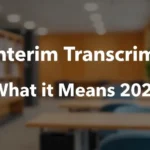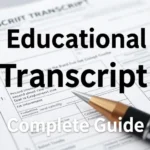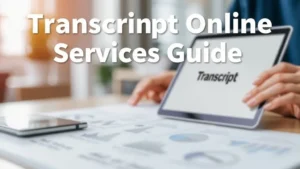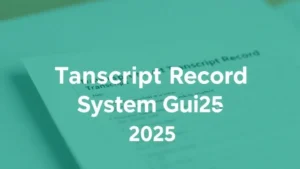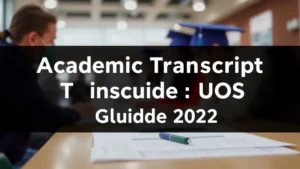Unofficial Transcript vs Official Guide
You’ve been there: you need your academic history fast, but what you find is an unofficial transcript instead of a sealed, certified document. It can be frustrating (and a little nerve-wracking). In this guide, you’ll learn the key differences between an unofficial transcript and an official transcript, when to use each one, and exactly how to obtain them in 2025. Plus, you’ll see real examples, expert quotes, and quick tips that make the process painless.
Here’s a surprising fact: 67% of U.S. institutions now accept unofficial transcripts for initial application review (CertifyMe, 2025). You’ll discover why that matters—and when you absolutely need the official version.
Table of Contents
- What Is an Unofficial Transcript?
- Official vs Unofficial Transcripts: Key Differences
- How to Obtain an Unofficial Transcript
- When to Use Unofficial Transcripts
- Limitations and Risks of Relying Solely on Unofficial Transcripts
- Future Trends: Digital Transcripts and Beyond
- FAQs
- 1. What is the difference between an unofficial transcript and an official transcript?
- 2. How long does it take to get an unofficial transcript?
- 3. Can I use an unofficial transcript for a job application?
- 4. What do I do if my transcripts are on hold?
- 5. Are digital transcripts accepted everywhere?
- Conclusion
What Is an Unofficial Transcript?
Ever wondered what sets an unofficial transcript apart from the official kind? Simply put, an unofficial transcript is an internal record of your courses, grades, and credits, typically generated through a student portal or emailed as a plain PDF. It lacks watermarks, seals, or digital signatures.
Here’s the thing: it’s free, usually instant, and great for your own reference. But since it isn’t certified by the registrar’s office, you can’t use it for final admission or credential verification.
Example: Jane logs into her college’s Major Portal and downloads her unofficial transcript in seconds. No fees, no waiting.
“Unofficial transcripts are available 24/7 through our student portal. Official copies require a signed request form and processing time.” – Millsaps College Office of Records
Actionable Takeaway: Check your institution’s portal first. You might already have access to a PDF you didn’t know about.
Official vs Unofficial Transcripts: Key Differences
Not all transcripts carry the same weight. Understanding their differences can save you from last-minute scrambling.
- Certification: Official transcripts include an institutional seal or digital signature; unofficial ones don’t.
- Delivery: Official transcripts are sent directly to third parties; unofficial transcripts go to you.
- Cost & Timing: Unofficial = usually free & immediate; Official = $5–$15 and 7–14 days.
- Use Cases: Unofficial for personal review or draft applications; Official for final admission, job verifications, and licensing.
Case Study: A student uses an unofficial transcript for an internship application, then sends the official copy when the employer requests verification. Problem solved.
Expert Insight: “Most graduate programs use unofficial transcripts for preliminary screening—saving time and money on both sides.” – Dr. Emily Rivers, Education Consultant
Actionable Takeaway: Always confirm with the recipient which transcript type they require.
How to Obtain an Unofficial Transcript
Need it fast? Here’s how to grab your unofficial transcript in just a few clicks.
- Log into your student portal (Major Portal or equivalent).
- Navigate to the Academic Records or Transcripts section.
- Select “Unofficial Transcript” and choose PDF or HTML format.
- Download or email it to yourself.
- Save a copy and print if needed.
In some schools, you can also request via email or in person at the registrar’s office. It’s free—and usually instantaneous.
Actionable Takeaway: Keep an unofficial copy on your device for easy sharing during interviews or advising appointments.
When to Use Unofficial Transcripts
Can you use an unofficial transcript for college applications? You might be wondering where it fits in.
Unofficial transcripts are perfect for:
- Initial college or scholarship applications.
- Job applications that only need a quick GPA check.
- Personal record-keeping or academic advising sessions.
- Drafting your resume or LinkedIn profile.
Actionable Takeaway: Ask upfront—don’t let an avoidable oversight cost you an admission spot or job offer.
Limitations and Risks of Relying Solely on Unofficial Transcripts
It’s free. It’s fast. But is it enough? Not always.
Unofficial transcripts lack legal standing. They can be altered, misread, or misrepresented—raising questions about authenticity.
Consider this: some institutions withhold all transcripts (official and unofficial) if you owe tuition or fees. That includes your quick-download PDF.
“Unofficial transcripts may be blocked due to outstanding balances, affecting both immediate and future requests.” – UniAcco Blog
Actionable Takeaway: Clear any holds on your student account before requesting transcripts of any kind.
Future Trends: Digital Transcripts and Beyond
Digital is the future—transcripts aren’t left behind. Secure PDF credentials with blockchain seals are on the rise.
Services like EduTranscript by CertifyMe let you order official transcripts online and track delivery in real time. No envelopes, no stamps, no hassle.
Interestingly enough, some employers now scan QR codes on transcripts to verify authenticity instantly.
Actionable Takeaway: Ask your institution if they offer digital, tamper-proof transcripts—this could save you days.
FAQs
1. What is the difference between an unofficial transcript and an official transcript?
Unofficial transcripts are for your eyes only—no seals, signatures, or direct-to-institution delivery. Official transcripts are certified records sent directly to third parties.
2. How long does it take to get an unofficial transcript?
Generally instant via portal or within 1–2 business days if requested by email or in person.
3. Can I use an unofficial transcript for a job application?
Yes, if the employer only needs to see your grades. But for background checks or formal verification, you’ll need the official version.
4. What do I do if my transcripts are on hold?
Check your student account for outstanding balances or requirements. Resolve any holds, then request again.
5. Are digital transcripts accepted everywhere?
Most institutions and employers now accept secure digital transcripts, but confirm before ordering.
Conclusion
To summarize: an unofficial transcript is fast, free, and handy for drafts or initial reviews, while an official transcript carries the seal of authenticity needed for final admission, job verification, and licensure. You’ve seen how to get each type, when to use them, and what pitfalls to avoid.
Next steps:
- Log into your portal and download your unofficial transcript.
- Check for any account holds—clear fees or requirements first.
- Order the official transcript when and where it’s truly necessary.
The bottom line is: knowing when and how to use each transcript type keeps your applications on track (and your deadlines met). Go get that record—and good luck!
See also: Ordering Unofficial Transcript Online and Transcript Request Process.
Learn more about FERPA compliance at the U.S. Department of Education and academic transcript basics on Wikipedia.

